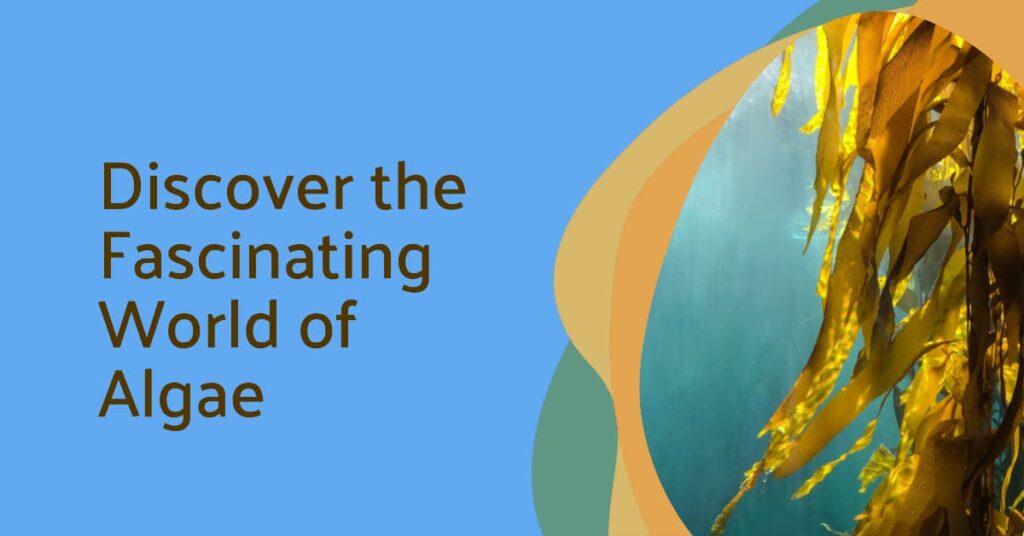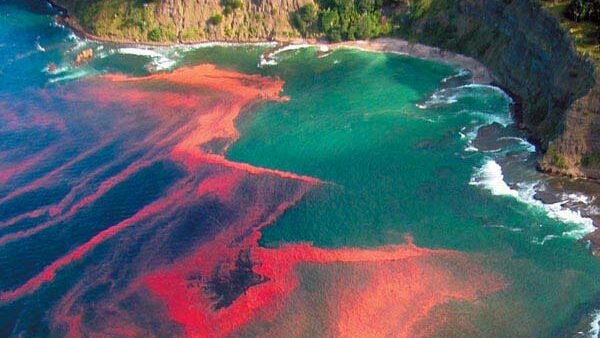Algae, a diverse group of aquatic organisms, play a crucial role in our ecosystems and have a significant impact on various industries such as energy, food, pharmaceuticals, and the environment.
These photosynthesizing organisms can be found in various forms, from microscopic species to massive seaweed structures. Interestingly, algae are not merely passive inhabitants of the aquatic environment; they have dynamic effects on their surroundings, from providing essential nutrients to being key players in maintaining the ecosystem balance.
Their ability to produce oxygen through photosynthesis makes algae a critical component of the Earth’s life support system. Apart from that, algae produce an array of useful compounds, including essential fatty acids, proteins, vitamins, and pigments that are utilized in a multitude of applications.
Furthermore, the potential of algae as a renewable energy source, pollution control agent, and sustainable animal feed ingredient has drawn significant attention from researchers, industries, and environmentalists alike.

Key Takeaways
- Algae are diverse aquatic organisms, that play a vital role in ecosystems and various industries.
- These organisms contribute to oxygen production while offering nutrient-rich compounds for numerous applications.
- Algae hold significant promise in areas such as renewable energy, environmental protection, and sustainable animal feed.
Types of Algae
Green Algae
Green algae are a diverse group of photosynthetic organisms that can be found in various aquatic environments, such as freshwater, marine, and even some terrestrial habitats. They play a crucial role in ecosystems, providing oxygen and acting as primary producers in the food chain.
Green algae are eukaryotic and contain chlorophyll, which is responsible for their green color. They come in various forms, such as unicellular, multicellular, and colonial species. Some well-known examples of green algae include Chlamydomonas, Spirogyra, and Ulva1.
Red Algae
Red algae, also known as Rhodophyta, are predominantly marine organisms found in both shallow and deep waters. Their red color is due to the presence of a pigment called phycoerythrin, which allows them to capture sunlight more efficiently in deeper water2.

Red algae are important contributors to the marine ecosystem, as they are primary producers and serve as a habitat for various aquatic species.
Many red algae are known for their unique calcified structures, such as coralline algae, which play a key role in building and maintaining coral reefs. Some popular examples of red algae are Irish moss and dulse.
Brown Algae
Brown algae are another essential group of algae, mostly found in marine environments. They get their brown color from a pigment called fucoxanthin, which is dominant over green chlorophyll.
This group of algae is known for some of the largest and most complex species, such as kelp, which can form dense underwater forests3. These kelp forests provide vital habitat for a multitude of marine species. Fucus and Sargassum are other common types of brown algae typically found in coastal areas.
Blue-Green Algae
Blue-green algae, also known as Cyanobacteria, are a unique group of photosynthetic bacteria found in a wide range of environments, including fresh and saltwater bodies, soil, and even in extreme conditions like hot springs.
Although not technically algae, they are often classified and discussed in the context of algae due to their similar characteristics and functions4. Blue-green algae can produce their own food through photosynthesis and are responsible for some of the earliest evidence of oxygen-producing photosynthesis on Earth. Some common types of blue-green algae include Spirulina and Anabaena.
Footnotes
Algae Anatomy
Microscopic Structures
Algae are fascinating and diverse organisms, displaying a wide range of microscopic structures. They can be unicellular or multicellular, and their cells contain various organelles similar to those found in higher plants.
However, unlike plants, algae generally do not have true leaves, stems, or roots. Instead, they possess simple structures that aid in growth and reproduction. Some algae can even be viewed under a microscope, revealing intricate details of their cellular organization.
Algal cells typically contain chloroplasts for photosynthesis, which allows them to produce energy from sunlight. These chloroplasts are responsible for the green coloration commonly associated with algae. In addition, algae contain other cell structures such as the nucleus, mitochondria, and a protective cell wall. Microscopic examination of algae can provide valuable information about their taxonomy, reproduction, and ecological roles.
Multicellular Formation
While many algae species are unicellular, there are also numerous forms of multicellular algae. These algae form complex, often branching structures with varying degrees of differentiation.
The growth of multicellular algae can be either filamentous (long, thread-like strands) or thalloid (flat sheets or irregular shapes). Despite lacking true leaves, stems, or roots, multicellular algae have adapted to their environments in unique ways.
In filamentous algae, cells are joined end-to-end, creating long chains that can grow and reproduce. These filaments can sometimes form dense mats or floating aggregates on the water’s surface. Thalloid algae, on the other hand, grow in flattened structures and can be found on rocks, trees, or even as symbiotic partners in lichen.
The simplicity and adaptability of multicellular algae have contributed to their ecological success and widespread distribution in various aquatic and terrestrial habitats.
Photosynthesis and Oxygen Production
Chlorophyll and Sunlight
Algae are fascinating organisms known for their ability to conduct photosynthesis, just like plants. They harness sunlight to produce energy using chlorophyll, a light-absorbing pigment. Chlorophyll is responsible for the green color of many algae species and plays a pivotal role in the photosynthetic process, where sunlight is converted into chemical energy.
The light absorbed by chlorophyll molecules is used by algae to combine carbon dioxide and water to create glucose and oxygen. This process is not only essential for the growth and survival of algae but also has a significant impact on oxygen levels in the environment.
Carbon Dioxide Conversion
Algae are highly efficient in converting carbon dioxide into oxygen through photosynthesis. As aquatic organisms, they have a remarkable ability to absorb carbon dioxide dissolved in water, making them excellent agents for reducing greenhouse gas emissions. This high rate of carbon dioxide conversion contributes to the oxygen production by algae, directly affecting global oxygen levels.
During daylight hours, when sunlight exposure is at its peak, photosynthesis occurs in algae at an accelerated rate, leading to the release of oxygen as a by-product of the process.
As algae can be found in various ecosystems, including oceans, rivers, and soil, their photosynthetic activities play a crucial role in maintaining a balanced ecosystem and healthy oxygen levels for the planet.
Algae’s Role in the Ecosystem
Food Chain Importance
Algae play a vital role in aquatic ecosystems as they form the base of the food chain. These photosynthesizing organisms convert sunlight into energy and serve as primary producers.
Algae are consumed by various marine life, including small creatures like zooplankton and larger animals such as fish. The energy stored within algae travels up the food chain, eventually reaching apex predators like sharks and whales.
In addition to sustaining marine life, algae also contribute to the production of 30-50% of the oxygen we breathe on Earth 1.
Habitat for Aquatic Life
Aquatic habitats like ponds, lakes, oceans, and rivers are heavily influenced by the presence of algae. These organisms, especially phytoplankton, serve as both food and shelter for numerous fish and animal species.
Dense algae growth, known as algal blooms, can provide hiding spots for small fish and breeding grounds for aquatic invertebrates. Additionally, some species of fish lay their eggs on seaweeds, a type of algae, to provide protection and camouflage.
The healthy growth of algae in these aquatic environments helps maintain the balance of ecosystems and supports biodiversity 2.
Footnotes
Nutritional Elements
Protein Content
Algae, particularly seaweed and kelp, contribute significantly to the protein sources available in our diets. Some varieties of algae contain as much as 40% of their dry weight in protein, making them a valuable food source. In comparison, beef and chicken contain approximately 25% and 19% protein, respectively1.
Uses in Food Industry
Algae have been part of the human diet for thousands of years, with archaeological evidence dating back to 14,000 years ago in Chile2. They have been used in various culinary applications, including:
- Seaweed: A popular component in many traditional dishes, especially in Asian countries, seaweed is particularly well-known for its use in sushi. It provides a unique texture and flavor, as well as essential nutrients.
- Kelp: Another type of algae, kelp is a staple food source for several marine species and is often used in human cuisine as well. Kelp is an excellent source of minerals, vitamins, and dietary fiber3.
- Agar: Extracted from red algae, agar is a natural gelatin substitute that serves as a thickener, stabilizer, or gelling agent in various food products. Its applications include the preparation of dessert jellies, sauces, and even vegetarian marshmallows4.
- Carrageenan: A polysaccharide extracted from red seaweeds, carrageenan is commonly used as a food additive for its ability to act as a thickener, binder, or emulsifier. Some common food items that contain carrageenan include ice cream, yogurt, and processed meats5.
These examples showcase the versatility, nutritional value, and unique properties algae bring to the food industry while offering a sustainable and environmentally friendly alternative to traditional food sources.
Footnotes
Algae in Animal Feed
Algae are versatile organisms that play a crucial role in various ecosystems, including marine environments where they serve as the base of the food chain.
In recent years, the use of algae for animal feed has gained attention as a sustainable alternative to traditional feed sources like soy and fishmeal. As algae are nutrient-rich and can be produced more sustainably than other inputs, they are becoming increasingly appealing for feeding livestock.
One of the key benefits of using algae is that they possess high levels of essential nutrients like proteins, vitamins, and minerals. These nutrients provide ample nourishment for a wide range of animals, including poultry, pigs, fish, and even cattle. With the rising cost of traditional feed ingredients, algae can offer a cost-effective and environmentally friendly solution for livestock nutrition.
Studies have also shown that incorporating algae into animal feed can improve the health and performance of animals. For example, when included in poultry feed, algae can enhance the color of the skin, shanks, and egg yolks, making the final products more visually appealing for consumers. Additionally, certain types of microalgae have been found to improve immune function and gut health in pigs, leading to better overall health and performance.
The growing interest in algae as an alternative source of animal feed has led to numerous innovations in production methods. For instance, closed-loop photobioreactors can be used to cultivate microalgae in a controlled environment, ensuring consistent and high-quality feed ingredients. Moreover, some companies are developing systems to harvest marine macroalgae, which can provide a more readily available biomass for animal nutrition.
In conclusion, the use of algae in animal feed presents a promising solution for meeting the nutritional needs of livestock, while also addressing some of the environmental challenges associated with traditional feed production. With continued research and technological advancements, algae-based feed ingredients have the potential to revolutionize the animal nutrition industry and contribute to more sustainable livestock farming practices.
Harmful Algal Blooms
Harmful algal blooms (HABs) occur when colonies of algae grow rapidly in freshwater or marine environments. These overgrowths can be triggered by various factors, such as nutrient pollution and changes in water temperature. In some cases, HABs can produce toxins that have negative impacts on humans, animals, and the environment.
Eutrophication
A major cause of harmful algal blooms is eutrophication, which is the excessive enrichment of water bodies with nutrients, particularly nitrogen and phosphorus. These nutrients often come from sources like agricultural runoff, sewage, and industrial waste. Eutrophication promotes the rapid growth of algae, leading to dense algal blooms that can deplete oxygen levels in the water and cause ecological imbalances.
Impacts on Environment
Harmful algal blooms can have various negative impacts on the environment. One well-known example is the phenomenon known as red tide, which occurs when a massive increase in the number of algae in the ocean leads to harmful effects on marine life. HABs can also cause oxygen depletion in the water, known as hypoxia, resulting in the death of fish and other aquatic organisms.
Furthermore, HABs can disrupt the food chain by producing toxins that accumulate in the organisms consuming the algae. These toxins can then be transferred up the food chain, affecting higher-level predators and ultimately human populations that consume the contaminated seafood.
In summary, harmful algal blooms are a significant environmental concern due to their potential impacts on various ecosystems and human health. Addressing the root causes, such as nutrient pollution and eutrophication, is essential for mitigating and preventing these harmful events.
Blue-Green Algae and Toxins
Blue-green algae, also known as cyanobacteria, are a group of photosynthetic bacteria that often produce toxins. These toxins can be harmful to both humans and animals and can cause various symptoms, such as skin irritation, nausea, and sore throat. This section will discuss the characteristics of cyanobacteria and their detrimental effects on the environment.
Cyanobacteria
Cyanobacteria are ancient microorganisms that have adapted to various environments, including freshwater, saltwater, and even terrestrial habitats. Despite their name, they come in various colors, from blue-green to red or brown. Some species of cyanobacteria produce harmful toxins, which can lead to health issues. For example, liver toxicity is one possible effect, with symptoms such as abdominal pain, diarrhea, and vomiting appearing hours or even days after exposure to the toxins. Another potential health concern is neurotoxicity, where symptoms can appear within 15 to 20 minutes after exposure, leading to neurological issues, seizures, and respiratory problems.
Detrimental Effects on Environment
Blue-green algae blooms can have significant impacts on the environment. They can reduce water quality by decreasing oxygen levels, which in turn can lead to the death of fish and other aquatic life. Furthermore, these harmful blooms can be caused by many types of phytoplankton, including dinoflagellates and diatoms, in addition to cyanobacteria. The toxins produced by cyanobacteria can also make their way into the food chain, causing health problems for wildlife that ingest contaminated water or prey.
Not only do blue-green algae blooms harm aquatic ecosystems, but they can also occur in lakes and ponds that provide drinking water to nearby communities, leading to potential issues for human health. In some cases, large-scale blooms can even release harmful gases into the air, which can exacerbate respiratory issues of individuals in the area.
In summary, blue-green algae, particularly the toxic-producing cyanobacteria species, pose threats to both human and animal health, as well as the overall well-being of our aquatic ecosystems. Preventing and managing these harmful blooms will be crucial in ensuring the safety of our water resources and preserving the health of our environment.
Algae and Climate Change
Carbon Sequestration
Algae play an essential role in carbon sequestration, which is the process of capturing and storing carbon dioxide to help mitigate climate change. These photosynthesizing organisms consume CO2 as part of their growth process, converting it into biomass. Most microalgae grow through photosynthesis by converting sunlight and CO2 into biomass, essentially acting as natural filters that remove excess carbon dioxide from the atmosphere 1.
Moreover, algae are known to grow rapidly, and some species even double their biomass within a day, making them highly efficient in capturing and storing carbon dioxide 2.
Mitigating Greenhouse Gas Emissions
Another contribution algae offer in the fight against climate change is their potential use as a sustainable source of biofuels, which can help reduce reliance on fossil fuels and therefore reduce greenhouse gas emissions. Algae-derived biofuels have been shown to produce significantly less CO2 per gallon than traditional fossil fuels, and they can potentially be cultivated in a variety of environments, including areas unsuitable for traditional crops 3.
In fact, it has been reported that algae can produce up to 5,000 biofuel gallons per acre per year, greatly surpassing the yields of other biofuel crops like corn and soybeans 4.
In conclusion, the fast-growing and highly efficient nature of algae make them important players in addressing climate change and global warming through their ability to sequester carbon dioxide and contribute to the production of sustainable biofuels.
Footnotes
Algae Energy and Biofuels
Microalgae in Biofuel Production
Microalgae are small aquatic organisms that play a vital role in the production of biofuels. They can efficiently convert sunlight and CO2 into biomass through photosynthesis, making them a promising alternative to fossil fuels1. The biomass obtained from microalgae can be processed to produce biofuels like biodiesel and bioethanol, which are more sustainable sources of energy.
One noteworthy aspect of using microalgae in biofuel production is their ability to grow rapidly under varying environmental conditions. Moreover, they don’t compete for land resources with food crops, thereby avoiding potential conflicts between food and fuel production. Additionally, algae-based biofuels have the potential to significantly reduce greenhouse gas emissions compared to conventional fossil fuels.
Macroalgae for Biomass
While microalgae have been widely researched for biofuel production, macroalgae, commonly known as seaweeds, also hold significant potential as a source of biomass. Macroalgae can be found in various sizes and forms, from microscopic species to large tree-like structures such as giant sea kelp2.
Macroalgae can provide several advantages over other biomass sources. For instance, they don’t require arable land or freshwater, making them an abundant and easily accessible resource for biomass production. Additionally, macroalgae have high growth rates and can efficiently absorb CO2 from the atmosphere, contributing to a greener environment.
In conclusion, both microalgae and macroalgae present promising opportunities for producing sustainable biofuels. Their potential to reduce greenhouse gas emissions, along with their low resource requirements, make them an attractive alternative to fossil fuels in a world increasingly focused on sustainability and environmental conservation.
Footnotes
Algae in Pollution Control
Wastewater Treatment
Algae play a significant role in the treatment of wastewater. They help remove nutrients such as nitrogen and phosphorus, which can contribute to pollution if left unchecked. These microorganisms convert these nutrients into biomass and oxygen through the process of photosynthesis. The biomass can then be harvested and used for various applications, such as biogas production, while the released oxygen is often helpful for water quality.
The use of algae in wastewater treatment has the potential to reduce the amount of chemicals needed for the process, making it a more environmentally friendly option. Some wastewater treatment plants are already incorporating algae-based systems, taking advantage of their natural ability to remove excess nutrients and improve water quality.
Carbon Capture
Algae are also essential in the fight against climate change, as they can capture and store carbon dioxide (CO2). Through photosynthesis, they absorb CO2 from their surroundings and convert it into biomass and oxygen. This process is valuable since it removes CO2 from the atmosphere, helping to mitigate the effects of global warming.
Some industries, such as power plants, are exploring the use of algae to capture CO2 emissions from their facilities. By growing algae in proximity to those emission sources, the microorganisms can absorb the released CO2, effectively reducing the overall greenhouse gas emissions. This concept, known as algae-based carbon capture, has the potential to become a vital component of sustainable industrial practices and environmental protection efforts.
Algae and Pharmaceuticals
Algae are proving to be a valuable resource in the field of pharmaceuticals. They possess high bioactive potential, making them ideal candidates for developing new medicines and treatments.
One significant area of interest is the use of algae-derived compounds to combat antibiotic resistance. Researchers have identified a range of molecules in different algae species that possess anti-bacterial properties. These molecules may provide a novel solution to the growing issue of antibiotic resistance.
Another area in which algae are making waves in the pharmaceutical world is cancer treatment. Scientists have discovered that some species of algae produce compounds with anti-tumor properties. These unique compounds may be used to develop new medications aimed at targeting cancer cells.
In addition to their potential applications in treating bacterial infections and cancer, algae are also being explored in the areas of inflammation and pain management. Research has shown that certain types of algae possess anti-inflammatory and analgesic properties, making them a potential source of new pharmaceuticals for managing chronic pain and inflammation.
The development of algae-based pharmaceuticals is still in its early stages, but the initial findings are promising. As research continues, it is likely that we will discover even more potential applications for these diverse and resourceful organisms
Algae in Everyday Products
Algae serve a variety of functions and can be found in many everyday products. They have many uses due to their sustainable nature, abundance, and versatility. This section will discuss some of the common applications of algae in cosmetics and skincare, food additives, and as plastic alternatives.
Cosmetics and Skin Care
Algae are often incorporated into cosmetics and skincare products because of their natural nourishing and hydrating properties. For example, sunscreen products might contain algae-derived ingredients that help protect the skin from UV damage. Algae extracts can also be found in face masks, moisturizers, and serums, thanks to their antioxidant, anti-inflammatory, and skin-soothing abilities 4. Their versatility makes them an ideal ingredient for creating sustainable and nourishing beauty products.
Food Additives
Algae play a significant role in the food industry as additives and thickeners. Two popular examples include agar and carrageenan, which can be found in many processed foods such as ice cream, yogurt, and even vegan alternatives.
Agar, derived from red algae, is often used as a vegetarian gelatin substitute due to its natural gel-like properties, making it ideal for creating jellies and puddings. Carrageenan, another red algae product, acts as a stabilizer and thickener in a variety of food products, including dairy and non-dairy items, improving the texture and mouthfeel 1.
If you have ever enjoyed the silky-smooth consistency of ice cream on a hot day, you may have unknowingly been consuming algae-derived additives. They help improve the texture and consistency of the frozen treat while maintaining its appealing creamy look and feel.
Plastic Alternatives
The use of algae as a sustainable alternative to plastic has been gaining momentum in recent years. Researchers have found that they can convert algae biomass into biodegradable polymers. These algae-based plastics are eco-friendly and can be used to create a wide range of products, such as disposable cutlery, food packaging, and even toys 5.
As the world continues to seek sustainable solutions to counteract the negative impact of traditional plastic usage, algae-based plastics have the potential to make a significant positive impact on the environment.
References
[1] https://www.discoverwalks.com/blog/world/10-amazing-facts-about-algae-that-will-blow-your-mind/
[4] https://www.discovermagazine.com/planet-earth/20-things-you-didnt-know-about-algae
[5] https://www.energy.gov/sites/default/files/2023-01/beto-algae-fun-facts.pdf
Diverse Algae Environments
Algae are incredibly versatile organisms that thrive in a wide range of environments. This section will discuss some of the commonly known habitats in which algae can be found, which include freshwater, saltwater, and terrestrial environments.
Freshwater
In freshwater environments, such as ponds and lakes, algae play a crucial role in oxygen production and the food chain. There are many types of algae that reside in these freshwater habitats. One common example is phytoplankton, which are microscopic algae that float near the surface of the water. These minute organisms are essential to the aquatic ecosystem and contribute to a significant amount of global oxygen production.
Saltwater
Algae are also abundant in saltwater environments like oceans, where they serve as the foundation of marine food chains. Seaweed is a familiar example of algae present in saltwater habitats. Some species of seaweed, such as kelp, can grow to impressively large sizes and form underwater kelp forests. These kelp forests provide vital habitats for a diverse array of marine creatures, including fish, crustaceans, and mollusks.
Terrestrial
Algae are not only restricted to aquatic environments; they can also be found in terrestrial habitats, such as soil. This may come as a surprise to some, but certain species of algae have adapted to survive and thrive on land. For instance, cyanobacteria are a type of algae that can exist in the soil and help in the process of nitrogen fixation, contributing to the overall fertility of the soil.
Moreover, some algae even thrive in unexpected places like polar regions, where they can form a phenomenon known as watermelon snow. In this case, the ice-loving algae species Chlamydomonas nivalis colors the snow with a pinkish-red hue, creating a visually stunning spectacle.
Classification of Algae
Kingdom Protista
Algae belong to the Kingdom Protista, which consists of diverse eukaryotic organisms that are neither plants, animals, nor fungi. In this kingdom, algae are classified based on their specific diagnostic features and taxonomy. They differ from plants by not having specialized multicellular reproductive structures, and from animals and fungi by being photosynthetic.
Eukaryotic Organisms
As eukaryotic organisms, algae possess a true nucleus enclosed by a nuclear membrane, as well as membrane-bound organelles. This sets them apart from prokaryotes like bacteria, which lack membrane-bound structures. Algae’s diverse forms range from single-celled individuals to large, complex multicellular structures like kelp.
The classification of algae within the kingdom Protista has undergone significant changes since the 1960s. However, their role as primary producers in aquatic ecosystems remains undisputed, and they continue to play a key role in providing oxygen and serving as a foundational food source for a wide variety of organisms.
Bioluminescent Algae
Bioluminescent algae are a fascinating group of tiny marine organisms with the ability to produce an ethereal glow in the dark. This intriguing phenomenon is the result of a chemical reaction known as bioluminescence. This type of chemiluminescence occurs when certain compounds within the algae react together, leading to the production of light.

One example of these captivating microorganisms is a dinoflagellate called Noctiluca or sea sparkle. These tiny creatures are so small that thousands of them can fit in a single drop of water. They are commonly found in coastal waters, where their mesmerizing light displays are most often observed.
Bioluminescent algae can be found in various regions and sea depths, but some of the most stunning displays are reported in places like Puerto Rico’s Bioluminescent Bay and Australia’s Jervis Bay. These unique ecosystems offer the perfect conditions for the growth and proliferation of bioluminescent algae.
The light produced by bioluminescent algae serves multiple purposes. For some species, it helps attract prey, while for others, it acts as a defense mechanism by either startling predators or attracting even larger predators to attack their primary threat. These dazzling displays are not only visually captivating but also serve essential roles within marine ecosystems.
In conclusion, bioluminescent algae are vital components of aquatic environments and contribute significantly to their health and biodiversity. Their ability to produce light through bioluminescence makes them a wonder to observe and showcases the incredible adaptability and diversity of life on Earth.
Algae and Coral Reefs
Algae play a crucial role in the health and sustainability of coral reefs. They are a primary food source for various herbivorous fish, such as surgeonfish, damsels, blennies, butterflyfish, and angelfish. Algae, though low in nutrients, contribute to maintaining the balance of the reef ecosystem by providing these fish with sustenance.
One significant aspect of the relationship between coral and algae is their symbiotic partnership. Corals rely on the sugars produced by algae, which account for 90% of their energy needs. In return, corals offer nitrogen and shelter to the algae, creating a mutually beneficial and essential relationship for both organisms1. This symbiotic relationship is the backbone of vibrant coral reefs, which are critical habitats for numerous marine species.
However, when ocean temperatures rise, corals become stressed and may expel the algae living within their tissues. This expulsion leads the corals to appear white, a phenomenon known as coral bleaching2. Bleaching significantly weakens the corals and can lead to their ultimate demise if the symbiotic relationship with algae is not reestablished.
Another vital function of algae on coral reefs is their role as architects. Coralline algae, a group of pink, encrusting plants, secrete calcium carbonate, which cements coral reefs together, providing structural integrity3. The presence of coralline algae enhances the overall stability and resilience of coral reefs, enabling these valuable ecosystems to support an abundance of marine life.
In conclusion, algae’s role in coral reef ecosystems is of utmost importance, providing food, contributing to the symbiotic relationship necessary for coral survival, and serving as a structural component in reef construction. Protecting and preserving coral reefs means ensuring the health and diversity of algae within these vital ecosystems.
Footnotes
Frequently Asked Questions
What are the different types of algae?
There are various types of algae classified into three main groups: red, green, and brown algae. Red and green algae are mostly multicellular, while brown algae include a mix of multicellular and microscopic species. These groups have distinctive pigmentation, cell structure, and vary in habitats, with some preferring freshwaters while others thrive in saltwater ecosystems.
How does algae benefit the environment?
Algae play a vital role in our environment because they form the base of the marine food chain. They are primary producers, meaning they convert sunlight into energy through photosynthesis, providing essential nutrients for other organisms. Algae also contribute to oxygen production, with some studies indicating they produce up to 87% of the world’s oxygen. Additionally, they help remove significant amounts of carbon dioxide from the atmosphere, supporting our planet’s carbon cycle.
What’s a unique characteristic of brown algae?
One unique characteristic of brown algae is their ability to grow into enormous structures called kelps. Kelps can grow up to 200 feet in length, making them the largest algae in the world. These underwater forests create a crucial habitat for numerous marine species, acting as a shelter and a food source for various organisms.
Why is phytoplankton important?
Phytoplankton, a type of microscopic algae, form the backbone of marine ecosystems as they form the base of the food web for aquatic life. They are a primary source of food for zooplankton, small fish, and other marine animals. Phytoplankton also plays a crucial role in oxygen production and carbon sequestration, contributing to the overall health of Earth’s oceans and atmosphere.
Can algae have negative impacts?
While algae play a critical role in ecosystems, they can sometimes have adverse effects. Large-scale blooms, known as harmful algal blooms (HABs), can produce toxins that are dangerous to both aquatic life and humans. These HABs can lead to oxygen depletion in water bodies, causing fish kills and other negative impacts on marine life.
What makes green algae special?
Green algae, primarily occurring in freshwater habitats, is considered special due to its close evolutionary relationship to land plants. In fact, all plants evolved from green algae. This connection has enabled scientists to better understand the origins of various plant traits and the evolution of life on Earth. Green algae also play an essential role in maintaining the health and balance of freshwater ecosystems, providing food and oxygen for aquatic creatures.
- 11 Boat Salvage Yards in Texas – January 18, 2025
- 7 Boat Salvage Yards in Michigan – January 15, 2025
- Fire Hose SOLAS Requirements, Regulation 10: Ensuring Maritime Safety – January 9, 2025



